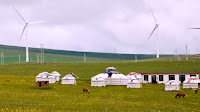The past year epitomized the toing-and-froing of planetary fortunes that have come to define global climate policy and debates.
In late 2015, a climate accord was struck by nearly 200 countries in Paris, potentially heralding a new era of international cooperation in reducing carbon pollution and slowing global warming. The pact was the result of extraordinary turnarounds by the world’s two greatest greenhouse gas polluters, China and the U.S., which had long resisted climate action.
Eleven months later, Americans elected Donald Trump as their next president, ushering into the White House a businessman who has falsely dismissed climate change as a Chinese hoax. His rhetoric on this issue is rejected by reams of science proving greenhouse gas pollution from power plants, exhausts, deforestation, and other sources has already caused global temperature to rise nearly 2°F.
Trump’s cabinet — full of climate doubters and denialists — and Republicans in Congress will likely attempt to drastically weaken or eliminate America’s byzantine environmental and climate regulations. But efforts outside of D.C. to slow warming can still progress, with some of America’s biggest states and some of the world’s most powerful countries vowing to forge forward with their efforts to reduce climate pollution.
The election appears to be energizing grassroots support for climate action as people across America were already turning to climate activism, blocking fossil fuel projects nationally and in their neighborhoods. Meanwhile, young people are suing governments in state and federal courts for allowing warming to threaten their futures.
Here are some of the key issues and places to watch this year as battles are waged against dirty energy, as climate policies are debated and implemented, and as governments abroad move to take over the leadership role that America seems poised to vacate.
Read more at Where to Follow the Climate Action in 2017

No comments:
Post a Comment